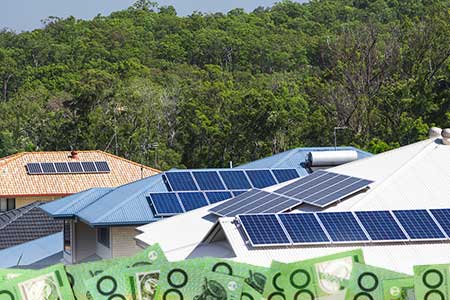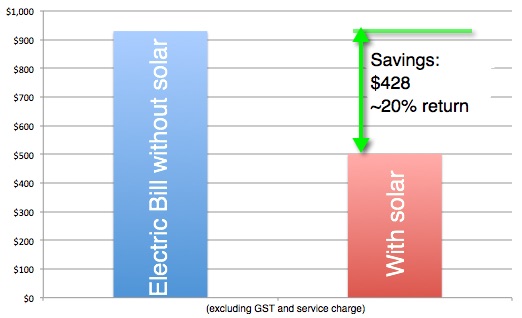How electricity companies are hiding the biggest solar savings
 By Finn Peacock – Chartered Electrical Engineer, Ex-CSIRO, Founder of SolarQuotes.com.au
By Finn Peacock – Chartered Electrical Engineer, Ex-CSIRO, Founder of SolarQuotes.com.au
I’ve been running this site for almost 7 years now. In the early days (when 5kW solar systems were 4x more expensive than they are now) you could get paid up to 60c for every kWh of solar electricity you generated.
For the last couple of years, though, as solar system prices have plunged, the Feed In Tariff rate at one point dropped to 8c per exported kWh of electricity.
This led to probably thousands of comments on the SolarQuotes Facebook page proclaiming that grid connect solar power is simply not worth it any more.
And I’ve gotta admit – many folks in the solar power fan club are as guilty as the skeptics on this one.
The solar skeptics say:
“Solar is an absolute rip off! You have to pay 31c per kWh to use electricity, but you only get 8c per kWh for selling it back to the grid. Proof that solar can NEVER pay for itself!”
I get a lot of this on my Facebook page. Usually with a lot more capital letters and swear words.
But many raving PV fans get stuck in too:
“Don’t let the greedy electric companies profit from your solar by selling energy to them for 8c, just so they can sell it right back to you for 31c! Buy a shed full of batteries and go off grid in suburbia like I did and never pay a power bill again!”
Both of these groups are misguided.
For example, when my solar system was on an 8c Feed in Tariff, my summer power bill was a piddly 33 bucks for a 6 person household.
So what was perpetuating this myth that, in 2016, solar was not worth it any more? Well, there are 2 things I’d like to clear up
#1: The 8c rate is a Net feed-in tariff. This means that you are only paid 8c kWh for solar electricity that you export. Solar energy that is not exported (i.e. consumed in your home) saves you 31c per kWh (at current electricity pricing), because you don’t need to buy it from the grid. I explain how this works in great detail here.
#2: Your savings from a solar system are much more than just the amount your electricity company credits you on your bill for your exported electricity. In fact, most of your savings are likely to be totally absent from the breakdown on your bill.
Funny that – it’s almost as if electricity companies want the benefits of solar power to look a lot smaller than they really are.
Let me explain:
Say your household uses 3,000 kWh of electricity per quarter. If you don’t have solar power, this means that you’re paying around 31c per kWh for every kWh.
3,000 kWh x 31c per kWh = A $930 quarterly bill for the non-solar owner (before fixed service charges and GST).
Now, let’s bring solar into the equation
If you generate electricity with your solar system and don’t feed it back into the grid (because you’ve used it to power something in your home), the electricity is ‘free’, or 0c per kWh. The sun isn’t out 24 hours a day, though – so this means that you can only get your ‘free’ electricity from around 8am – 6pm.
Still, let’s make the assumption that 40% of your electricity consumption is between the hours of 8am-6pm (when the sun is up and your system is generating electricity).
40% of 3,000 kWh = 1,200 kWh of self consumed solar.
This means that you’ve only had to buy 1,800 kWh from the grid at a price of 31c per kWh.
So the solar owner has only used $556 (31c/kWh x 1,800kWh = $556) of grid electricity.
Then, we credit the 8c per kWh for the solar energy that you’ve exported. If this is a 5kW system, you’d probably have exported about 700kWh of your solar. You would be credited 8c x 700kWh = $54.
$556 (bill with solar) – $54 (credit from exports) = $502 (net quarterly bill with solar).
Your new bill is therefore going to be $502 (before fixed service charges and GST).
You are actually saving $428 per quarter ($930 – $502 = $428), or over $1,600 per year with solar.
Once you combine the ‘invisible’ savings (from not needing to purchase electricity from the grid) with the net feed-in tariff, the amount of money solar saves you can translate to a very respectable return on investment.
For example: The 5kW system above would cost about $8,000 at today’s prices. That’s giving you a 20% return. And assuming electricity prices rise every year (a pretty safe bet), your return will increase every year for the 25+ years your solar system lasts. Try getting that from the bank!
Is $1,600 per year a good return on a 5kW solar system?
A good 5kW solar system, at the time of writing (January 2016), will cost you about $8k installed.
So $1,600 of annual savings is a simple payback of just over 5 years.
And this is where we come to another misconception about the returns from an investment in solar power. Many folks believe that a payback of 5 years means that they see no financial benefit for 5 years. This is wrong, wrong wrong! We need to take cash flow into account.
When you work out the actual cash flows, many folks find that they are actually losing money by not having solar (Oh dear – I really am starting to sound like a sleazy salesman – sorry – but please bear with me because this is true!)
Working out the simple cash flow for a $1,600 per year return on a $8,000 spend.
Most people either pay for solar power systems out of savings or add it to their mortgage.
If you have $8,000 in the bank right now it is probably earning about 4% interest. Let’s call it 5% to make the maths easy.
If you add $8,000 to your mortgage you are probably paying about 5% interest on it.
Either way you have an “opportunity cost” or “cost of finance” of 5%, ($400 per year) if you splash $8k on buying solar.
But outweighing this is the $1,600 per year I am saving with solar.
(And if you add it to your mortgage it should cost you about $10 per week to buy the solar system but could save you $30 per week. Wow.)
And just to be clear – I’m not saying you will get this return if you buy solar. You may get less, you may get more. Your savings will absolutely depend on how much electricity you consume in daylight hours.
The best way to see if you can get the kinds of returns illustrated in this example is to get a number of independent solar installers to do the maths for you based on your unique situation. Then you can decide if solar will work for you financially.
If you’re considering installing solar panels for your home, SolarQuotes can help you get 3 quotes from high quality installers (including payback calculations) quickly and easily:


